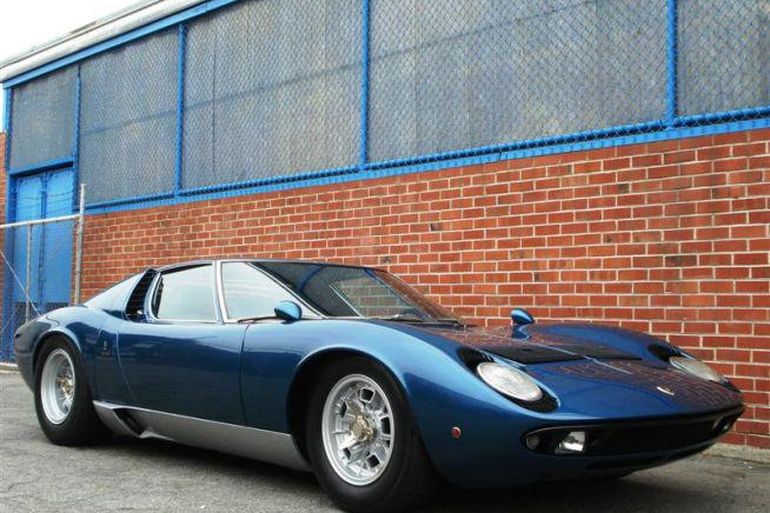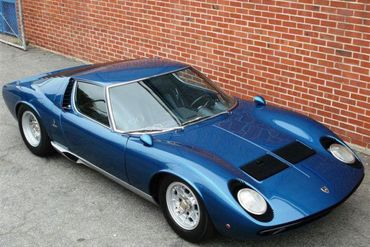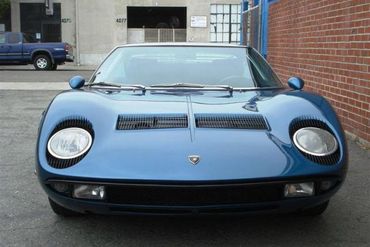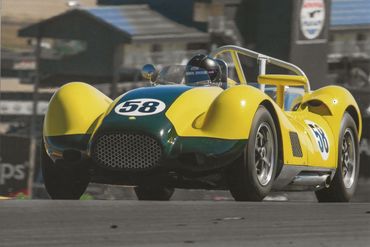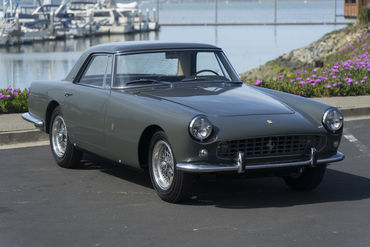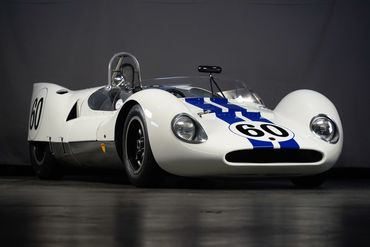Sold
SOLD 08/10
1970 Lamborghini
Miura P400 S
See New Pricing! One of 138 built. Late Production Example with SV Wheels and A/C.
- VIN4629
- Exterior ColorBlu Spettrale Metallizzato
- Interior ColorBlack Leather
- Mileage58706 Kilometers
- EngineDOHC Transverse 4.0L V12
- Engine no.30549
- TransmissionZF 5-Speed Transaxle
- StatusSold
- StockFJ827
Description
1970 Lamborghini Miura S
s/n 4629 engine no. 30549
Blu Spettrale Metallizzato with Black Leather Interior
Few cars have stunned like the Miura. Introduced in November of 1965 at the Turin Salon as just a naked chassis, the car created a sensation because of its radical mechanical layout. The sophisticated quad cam V12 was mounted amidships and transversely, creating a compact and balanced platform that went against almost all prior conventions about how to build fast cars. The press was sure Lamborghini was planning a race car, though in reality the car was a hastily conceived exercise to generate publicity. And generate publicity it did. Because of the huge response to the car, Lamborghini decided to build it, though they did not yet have a body. Bertone produced what is surely one of the most beautiful cars ever made and had a prototype ready just four months later, in time to show at Geneva in March of 1966. Orders poured in, and the plan to build perhaps fifty examples was soon scrapped. All told, over seven hundred Miuras would be built, effectively putting Lamborghini on the map, a shocking achievement considering that the firm was just three years old when the Miura was unveiled.
The car was then taken to Monte Carlo for the Monaco GP, drawing crowds five deep, despite the plethora of other exotic cars on hand and the jaded crowd at the casino. Legendary English journalist L.J.K. Setright took the car on a thousand mile tour of Europe for Car magazine, and called it a ‘supercar”, inventing the term that survives with us today to describe a very special automotive experience. The Miura was not dynamically perfect, but invented an entire genre of car and captured everything that was wonderful about motoring in the swinging sixties. Who really needs bumpers or proper rear visibility?
It was all about the colors, the style, the performance, and the noise. The response of the public and the press was almost universally effusive, but there were of course foibles, which in typically Italian fashion, would be ironed out as production proceeded. In November of 1968, the Miura became the Miura S, with the introduction of a number of refinements, including reshaping the combustion chambers, altering the camshafts and carburetion, for about twenty more horsepower. Build quality was improved, electric windows added, and a bit more chrome (on the headlights and window trims) was added. The rear suspension was revised, and on later cars, ventilated discs employed for the brakes.
Just 138 Miura Ss were built, and this particular car is a relatively late production example completed in July of 1970. It was equipped new with vented disc brakes and air conditioning, both desirable features that the car retains. The car was originally finished in Blu Spettrale Metallizzato a striking hue that the still wears. It spent many years in Japan before being imported to California in 2007, where it has remained since. The car has been sympathetically restored in its original colors and fitted with 9” rear wheels from a Miura SV, which transforms the car’s stance. The car is a matching numbers example.
The car is in lovely cosmetic condition. The paintwork was renewed to high standards and remains in excellent shape, with almost no blemishes. There is a handful of small cracks, but no other blemishes worth noting. The panels are straight and fit well. The chrome is possibly original and very nice considering this. The lamps and glass are very nice, with Carello headlamps and fog lamps. While both headlamps are Carello items, one of them has a slightly different curvature and reflector pattern. The windscreen has extremely light wear only and appears to be the original item. The wheels and spinners have been beautifully refinished, and the wheels bear the correct Campagnolo stickers.
The interior is also very nice, being predominantly unrestored. The seats were reupholstered recently in leather and are excellent, but the remaining upholstery, including the headliner, dashboard, center console, and door panels appears to be original, and extremely well-preserved. The carpets are also excellent, as are the switches and instruments.
The engine and front compartment have the look and feel of a car that has been well-cared for but never fully disassembled for restoration. The visible chassis and suspension components are solid and intact, and display some of the traces of the original craftsmen at work. The car is equipped with the correct horns, and the spare wears the correct Pirelli Cinturato CN12 tire. The other wheels are shod with Avon tires. The engine compartment is relatively clean, and the car retains its distributor cover. The airbox covers have correctly silkscreened FIAAM graphics. The trunk is in very nice shape as well, with nice carpet and nicely finished inner panels.
The underside of the car appears predominantly unrestored, and is in nice shape considering this. There appears to be one area of the floor replaced in the front of the car, but the remainder of the underside bears the patterning and details of the original, including the venting and ducting that was a feature of later Miuras. Its condition is consistent with a nicely cared for forty year old unrestored car.
The car drives very nicely, having been driven to Monterey from the San Francisco Bay Area (a round trip of approximately 250 miles) in August of 2009. The car has a nice tranaxle, brakes properly, and the engine makes great power and noise. The carburetors are nicely synched.
The Miura is the car that changed everything. Its historical significance is formidable because it is one of those rare specific moments that can actually be called a paradigm shift, and it was a truly mind-blowing car in its day. Today, the Miura has aged well. The styling is as gorgeous as ever, and has taken on a surprising sophistication and almost delicacy that is missing from the aggressively assertive supercars of today. Just 138 Miura Ss were built, making them the rarest of the three variants. This particular car is a nicely equipped matching numbers example that presents nicely, runs very well, and has some unique features, including its rare original color, SV wheels, and A/C.
The above vehicle information is complete and accurate to the best of our knowledge at the time it is posted to this website. Corrections or additional information is always appreciated. All advertised prices exclude government fees and taxes, any finance charges, any dealer document preparation charge, and any emission testing charge. Vehicles are subject to prior sale. All advertised to be true but not guaranteed. We assume no liability for errors or omissions.
Inquire About This Car
Fantasy Junction • 510-653-7555 • 1145 Park Ave, Emeryville, CA 94608
